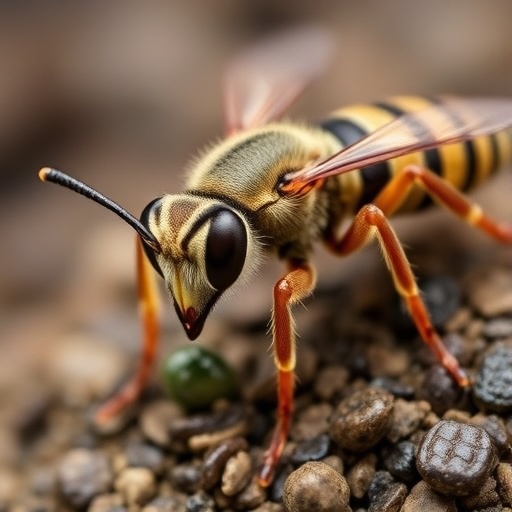Recent research has unveiled the complex interactions between agricultural chemicals and non-target organisms, shedding light on a pressing environmental issue. The study in question investigates the effects of sublethal concentrations of acephate, a widely used insecticide, on the demographic and behavioral traits of the larval parasitoid, Habrobracon hebetor. This species is not only significant in agricultural ecosystems but also serves as a vital agent for controlling pest populations, thereby enhancing crop yields and sustainability.
Acephate, an organophosphate insecticide, functions by disrupting the normal nervous system activity of insects, effectively targeting pests that threaten crops. However, the indiscriminate nature of such chemicals raises concerns about their impact on beneficial insects, which play essential roles in natural pest management. Understanding the implications of acephate exposure on non-target species is critical, particularly as agricultural practices continue to evolve and intensify worldwide.
The study conducted by Pradhan et al. meticulously monitored the behavioral responses of Habrobracon hebetor larvae exposed to various concentrations of acephate. By analyzing demographic attributes such as survival rates, development times, and reproductive success, the researchers aimed to elucidate the potential long-term consequences of pesticide application on these parasitoids. Their findings contribute valuable insights into how sublethal pesticide concentrations can undermine the efficacy of natural biological control mechanisms.
One of the striking outcomes of the research was the apparent alteration in the feeding behaviors of the exposed parasitoids. Changes in behavior are particularly concerning, as they can disrupt the ecological balances that underpin agricultural productivity. The parasitoids’ ability to locate and parasitize host pests was evidently compromised when subjected to acephate, signaling the potential for cascading effects throughout the food web.
Moreover, the study highlighted the extended impacts on the development rates of the larvae. The exposure to sublethal concentrations resulted in an increase in developmental times for Habrobracon hebetor, potentially leading to mismatched life cycles between the parasitoids and their host pests. This asynchrony can have dire consequences for the biological control of pest populations, effectively nullifying the benefits these parasitoids provide in managing agricultural challenges.
As the results were analyzed, it became clear that reductions in reproductive success were significant. The researchers documented lowered fecundity rates as a direct consequence of acephate exposure, which may hinder the population growth of Habrobracon hebetor in the wild. This finding underscores the need for farmers to consider the broader ecological implications of insecticide use, transcending the immediate benefits gained from pest eradication.
Furthermore, the research raises ethical questions about the use of chemical pesticides in agriculture. As farmers increasingly prioritize yield and profit, understanding the ecological ramifications of their practices becomes essential. The evidence presented by Pradhan et al. undoubtedly serves as a clarion call for more responsible pesticide application, ensuring that beneficial organisms are preserved alongside crop health.
Another pivotal aspect of the study is its implication for pest management strategies. Integrated pest management (IPM) practices hinge on the coexistence and functionality of natural pest controllers like Habrobracon hebetor. Thus, the adverse effects of acephate not only threaten individual species but can also undermine entire pest management frameworks that have been developed over decades.
In addressing these concerns, there is an urgent need for policymakers and agricultural stakeholders to reevaluate their reliance on chemical treatments. The data presented in this study should prompt a shift toward more sustainable pest management solutions that prioritize ecological balance as much as crop output.
In conclusion, the implications of Pradhan and colleagues’ findings extend far beyond the lab; they resonate across the agricultural landscape. The intricate interactions between pests, their natural enemies, and the chemicals introduced into their ecosystems must be studied and understood. This research exemplifies the vital need for deeper exploration into the unintended consequences of widely used agrochemicals, ultimately guiding the path toward a more harmonious coexistence between agriculture and ecology.
In conjunction with emerging regulations surrounding pesticide use, this research paves the way for more comprehensive guidelines that consider the intricacies of ecosystems. As the agricultural sector navigates the challenges of food production, the lessons learned from studies like this one will be pivotal in ensuring that growth does not come at the expense of ecological integrity.
The findings from this study will, hopefully, encourage scientists, farmers, and policymakers alike to collaborate in innovating novel pest management practices that align with both agricultural productivity and environmental stewardship, creating a resilient agricultural future.
By disseminating this crucial research, we can inspire action across various sectors, illuminating the path forward toward sustainable agriculture that balances human needs with those of the environment. Ultimately, the continuation of such studies and their integration into agricultural practices will be indispensable for fostering resilience in ecosystems and ensuring the health of our planet.
Subject of Research: Effects of sublethal acephate concentrations on the demographic and behavioral traits of Habrobracon hebetor.
Article Title: Sublethal acephate concentrations alter the demographic and behavioral traits of the non-target larval parasitoid, Habrobracon hebetor (Say).
Article References: Pradhan, P.P., Gadratagi, BG., Nayak, U. et al. Sublethal acephate concentrations alter the demographic and behavioral traits of the non-target larval parasitoid, Habrobracon hebetor (Say). Environ Sci Pollut Res (2025). https://doi.org/10.1007/s11356-025-37194-6
Image Credits: AI Generated
DOI: https://doi.org/10.1007/s11356-025-37194-6
Keywords: Acephate, Habrobracon hebetor, Sublethal concentrations, Pesticide impact, Biological control, Ecosystem health, Sustainable agriculture, Integrated pest management.




